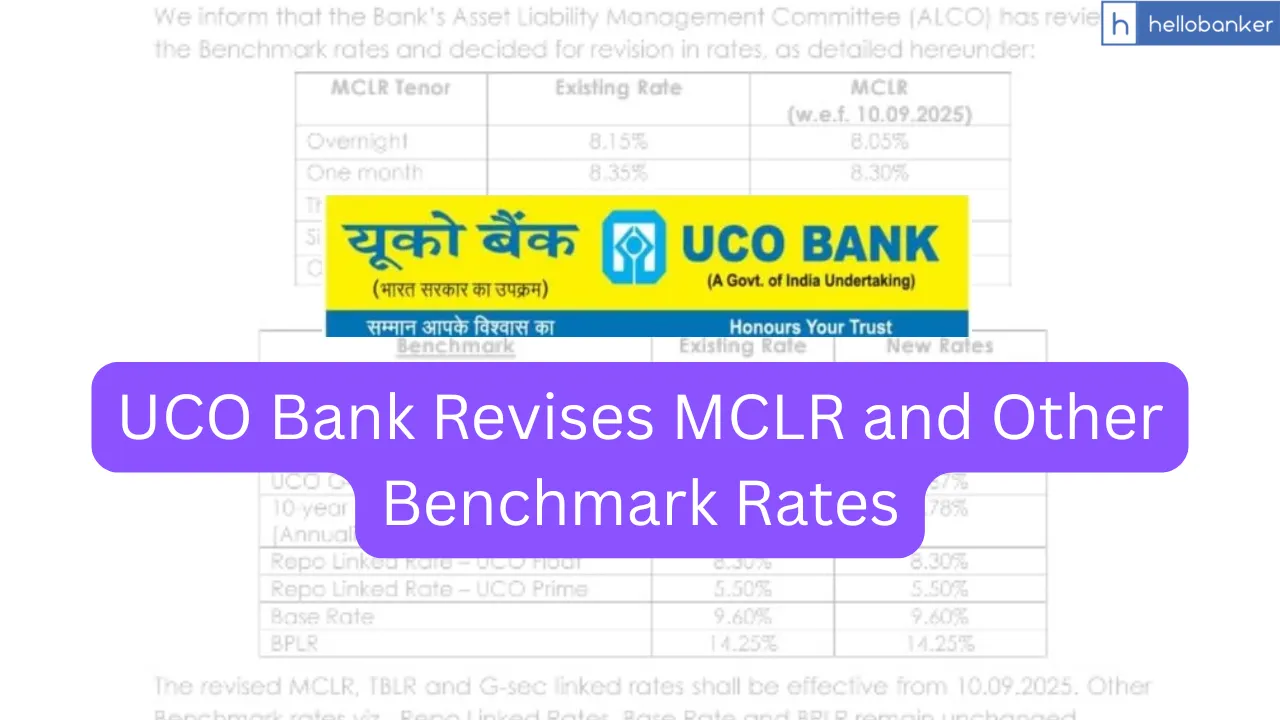New Delhi: UCO Bank, a prominent public sector player in India’s banking sector, has announced significant revisions to its Marginal Cost of Funds based Lending Rate (MCLR) and other benchmark rates, effective from September 10, 2025. These adjustments reflect a response to the evolving economic landscape influenced by the Reserve Bank of India (RBI) repo rate decisions amid rising inflation concerns.
MCLR Rates: What You Need to Know
UCO Bank’s recent update includes notable changes across various MCLR tenors, aimed at aligning its lending rates with current market conditions. The revised MCLR rates are as follows:
| MCLR Tenor | Existing Rate | MCLR (w.e.f. 10.09.2025) |
|---|---|---|
| Overnight | 8.15% | 8.20% |
| One month | 8.35% | 8.40% |
| Three months | 8.50% | 8.55% |
| Six months | 8.70% | 8.75% |
| One year | 8.95% | 9.00% |
These adjustments reflect UCO Bank’s commitment to maintaining competitive lending rates while managing operational costs and risk associated with lending. Higher MCLR rates generally lead to increased interest rates for loans, which can impact borrowers looking to finance major purchases such as homes or vehicles.
Understanding the Implications of MCLR Revisions
The recent changes in MCLR directly tie back to the overarching economic factors in India. With the Reserve Bank of India (RBI) adjusting the repo rate—an essential factor affecting borrowing costs—it’s crucial for banks to continually recalibrate their lending rates. As the RBI focuses on curbing inflation, these rate changes ensure that banks can manage their funding costs effectively.
For example, if you are considering taking a home loan from UCO Bank, the increase in the one-year MCLR from 8.95% to 9.00% means that your full-term mortgage could cost you more over the life of the loan, reflecting the bank’s efforts to stay resilient against rising operational costs fueled by inflationary pressures.
Other Benchmark Rate Adjustments
In addition to revising the MCLR, UCO Bank has also updated several other benchmark rates effective from the same date:
| Benchmark | Existing Rate | New Rates (w.e.f. 10.09.2025) |
|---|---|---|
| TBLR (3 month) | 5.35% | 5.35% |
| TBLR (6 month) | 5.50% | 5.50% |
| TBLR (12 month) | 5.55% | 5.55% |
| 10-year G-Sec (Prev. Year) | 6.68% | 6.81% |
| UCO 10-Year G-Sec Linked YTM % p.a. | 6.80% | 6.80% |
| Repo Linked Rate – UCO Float | 8.30% | 8.30% |
| Repo Linked Rate – UCO Prime | 5.50% | 5.50% |
| Base Rate | 9.60% | 9.60% |
| BPLR | 14.25% | 14.25% |
While other benchmark rates remain unchanged, UCO Bank is positioning itself to adapt quickly to the fluctuating market. These modifications indicate an acute awareness of external factors driving financial metrics and highlight the bank’s proactive strategy.
Looking Ahead: The Impact on Borrowers
For borrowers and prospective customers of UCO Bank, understanding MCLR is paramount. As banks adjust their rates, it directly influences monthly installments and overall loan affordability in the Indian economy. With inflation trends and the RBI’s monetary policy shaping market sentiment, financial planning becomes increasingly vital for consumers.
For instance, if you are planning to take a loan to start a small business, the new lending rates might require reassessing your budget and financing options. Awareness of how MCLR changes can directly impact your financial strategy could save you significant costs down the road.
Finally, as part of ongoing economic dynamics, individuals should stay informed about further adjustments that UCO Bank and other financial institutions may announce.
In conclusion, UCO Bank’s recent adjustments to MCLR and benchmark rates serve as a reminder of the constantly changing landscape in India’s banking sector. Understanding these changes is crucial not only for borrowers but for anyone keeping an eye on the broader economic environment.
Bankerpedia’s Insight 💡
UCO Bank’s revision of its MCLR and benchmark rates signals a crucial shift for India’s banking sector, reflecting broader economic trends. The incremental increases could raise loan costs for borrowers, impacting housing, education, and business financing. This move might tighten liquidity in the market, compelling banks to reassess their lending strategies. For consumers, it’s essential to understand how these rates affect your existing loans and potential borrowing, so review your financial plans and consider long-term implications before making any commitments.
How Does This Affect the Banking Ecosystem? 🏦
- Bank Employees → Increased borrowing costs for customers, affecting Bank Employees’ roles.
- Bank Management → Increased borrowing costs may impact loan demand heavily.
- Bank Customers → Higher borrowing costs for loans and mortgages ahead.
- Investors / Shareholders → Increased borrowing costs may reduce profit margins.
- Regulators (RBI, SEBI, Govt.) → Increased scrutiny on interest rates and banking stability.
- General Public → Increased borrowing costs for loans and mortgages.
Research References 📚
Loved our Research? ❤️
Bankerpedia turns financial confusion into clarity!
Subscribe to our YouTube channel for unbiased insights, financial literacy & practical banking wisdom.










